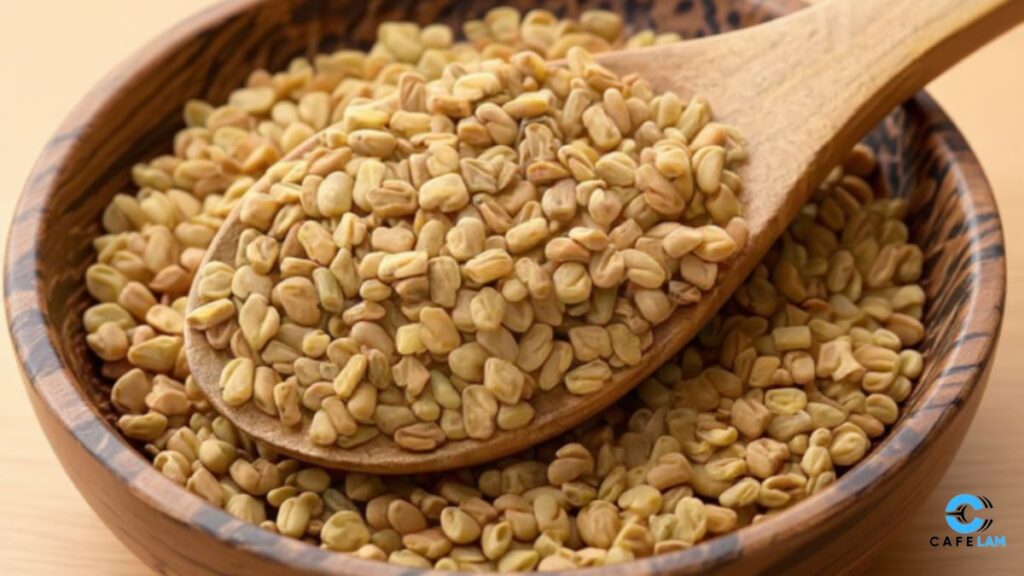Imagine a single herb that could help regulate your blood sugar, boost milk production in nursing mothers, and add incredible flavor to your favorite dishes. Foenegriek, known in English as fenugreek, delivers all these benefits and more in one remarkable package.
This golden-seeded wonder has been treasured for over 4,000 years across Mediterranean, Asian, and Middle Eastern cultures. Today, modern science validates what ancient healers knew instinctively about this powerful plant.
Whether you’re seeking natural health solutions or exploring new culinary adventures, understanding foenegriek opens doors to both wellness and flavor that you never knew existed.
What Makes Foenegriek So Special?
Foenegriek belongs to the legume family and produces small, triangular seeds with an unmistakable maple-like aroma. These amber-colored seeds pack incredible nutritional density into tiny packages that have sustained civilizations for millennia.
The plant grows annually and thrives in Mediterranean climates, producing pods that contain 10-20 seeds each. These seeds become the foundation for both culinary spices and therapeutic preparations used worldwide.
Scientific name Trigonella foenum-graecum literally translates to “Greek hay,” reflecting its historical importance in ancient Greek medicine and agriculture.
Nutritional Powerhouse in Every Seed
Each teaspoon of ground foenegriek delivers impressive nutritional content that rivals many superfoods. The seeds contain high levels of protein, fiber, iron, magnesium, and vitamin B6 that support multiple body functions.
Soluble fiber content reaches nearly 50% of the seed’s composition, making foenegriek exceptional for digestive health and blood sugar regulation. This fiber forms gel-like substances that slow sugar absorption and promote healthy cholesterol levels.
The seeds also provide significant amounts of phosphorus, copper, and manganese essential for bone health, energy metabolism, and antioxidant protection.
Key Nutritional Components per tablespoon:
- Calories: 35
- Protein: 3 grams
- Fiber: 3 grams
- Iron: 20% daily value
- Magnesium: 7% daily value
- Vitamin B6: 5% daily value
Evidence-Based Health Benefits
Modern research continues to validate traditional uses of foenegriek while uncovering new therapeutic applications. Studies demonstrate significant benefits for metabolic health, hormonal balance, and inflammatory conditions.
Blood sugar regulation represents one of the most well-documented benefits. Multiple clinical trials show that foenegriek consumption can lower both fasting glucose and post-meal blood sugar spikes in people with diabetes.
The herb’s galactagogue properties help nursing mothers increase milk production naturally. Research indicates that foenegriek supplementation can boost milk volume by up to 20% within the first week of use.
If you want to read more, visit our blog page. We have more topics!
Digestive Health and Beyond
Foenegriek’s high fiber content makes it exceptional for digestive wellness. The soluble fiber feeds beneficial gut bacteria while promoting regular bowel movements and reducing digestive inflammation.
Traditional medicine systems use foenegriek to soothe stomach upset, reduce acid reflux, and improve overall digestive function. Modern gastroenterologists often recommend it as a natural approach to managing irritable bowel syndrome symptoms.
The herb’s anti-inflammatory compounds help reduce intestinal inflammation while supporting healthy gut barrier function that protects against harmful bacteria and toxins.
Culinary Adventures with Foenegriek
In the kitchen, foenegriek transforms ordinary dishes into extraordinary culinary experiences. The seeds provide sweet, nutty flavors reminiscent of maple syrup and toasted nuts when used whole or ground.
Middle Eastern and Indian cuisines rely heavily on foenegriek for both flavor and preservation properties. The seeds naturally inhibit bacterial growth, making them valuable for food safety in warm climates.
Fresh foenegriek leaves, called methi, offer milder flavors perfect for salads, curries, and vegetable dishes. These leaves provide many of the same health benefits as the seeds while adding fresh, green flavors to meals.
Popular Culinary Applications:
- Spice blends and curry powders
- Bread and flatbread preparations
- Pickle and preservation mixtures
- Tea and beverage infusions
- Sprouted seeds for salads
- Fresh leaf preparations
Preparation Methods and Dosages
Different preparation methods unlock various aspects of foenegriek’s therapeutic potential. Raw seeds provide maximum fiber content, while toasted seeds develop deeper flavors and easier digestibility.
Soaking seeds overnight creates mucilaginous gels perfect for digestive support. This preparation method maximizes the soluble fiber’s benefits while making nutrients more bioavailable.
Ground foenegriek powder integrates easily into foods and beverages but loses potency over time. Fresh grinding preserves more active compounds than pre-ground products stored for extended periods.
| Preparation Method | Benefits | Recommended Dosage | Best Uses |
| Whole seeds | Maximum fiber | 1-2 tsp daily | Digestive support |
| Ground powder | Easy mixing | 1 tsp daily | Cooking, beverages |
| Soaked seeds | Enhanced absorption | 1 tbsp soaked | Blood sugar control |
| Tea infusion | Gentle effects | 1 cup 2x daily | General wellness |
| Sprouted seeds | Live enzymes | 1/4 cup daily | Salads, snacks |
Safety Considerations and Side Effects
Most people tolerate foenegriek well when used in culinary amounts. However, therapeutic dosages may cause side effects in sensitive individuals or those with specific health conditions.
Common side effects include digestive upset, bloating, and maple syrup-scented urine or sweat. These effects typically resolve as the body adjusts to regular consumption.
Pregnant women should avoid therapeutic amounts of foenegriek as it may stimulate uterine contractions. Nursing mothers can use it safely under healthcare provider guidance.
Selecting and Storing Quality Foenegriek
High-quality foenegriek seeds appear golden-brown with consistent size and shape. Avoid seeds that look dull, broken, or contain excessive debris that indicates poor processing.
Whole seeds maintain potency longer than ground forms when stored properly. Keep seeds in airtight containers away from light, heat, and moisture to preserve their active compounds.
Fresh foenegriek leaves should appear bright green without yellowing or wilting. Use fresh leaves within a few days of purchase for maximum nutritional value and flavor.
Was this helpful? If so, please keep browsing our site to find more useful information!
Growing Your Own Foenegriek
Home gardeners can easily grow foenegriek in temperate climates with well-drained soil and full sun exposure. The plants require minimal care once established and provide both fresh leaves and mature seeds.
Seeds germinate quickly in spring soil temperatures above 60°F. Plants mature in 3-4 months, producing harvestable leaves throughout the growing season.
Harvest leaves continuously for fresh use, or allow some plants to mature completely for seed collection. Properly dried seeds store for several years when kept in sealed containers.
Integrating Foenegriek into Daily Life
Starting with small amounts allows your body to adjust gradually to foenegriek’s effects. Begin with 1/4 teaspoon daily and increase slowly based on your tolerance and desired benefits.
Morning consumption often works best for blood sugar control, while evening use may support digestive health overnight. Experiment with timing to find what works best for your lifestyle and health goals.
Combining foenegriek with other complementary herbs and spices can enhance both flavor and therapeutic effects. Turmeric, ginger, and cinnamon pair particularly well with foenegriek in both culinary and medicinal preparations.
The Future of Foenegriek Research
Ongoing studies continue exploring foenegriek’s potential for treating various health conditions. Researchers investigate its effects on cholesterol levels, testosterone production, and weight management with promising preliminary results.
Clinical trials examining foenegriek’s anti-cancer properties show encouraging outcomes for certain tumor types. These studies may lead to new therapeutic applications beyond traditional uses.
Agricultural research focuses on developing foenegriek varieties with enhanced nutritional profiles and improved growing characteristics for different climate zones.
Conclusion
Foenegriek represents a perfect bridge between ancient wisdom and modern science. This versatile herb offers proven health benefits while adding unique flavors to countless dishes.
Whether you choose foenegriek for its blood sugar benefits, digestive support, or culinary potential, you’re connecting with thousands of years of human experience. Start small, be consistent, and discover how this remarkable herb can enhance your health and cooking.
The journey with foenegriek begins with a single seed, but the benefits can last a lifetime when you make this ancient herb part of your modern wellness routine.
Frequently Asked Questions
Q: Can foenegriek interfere with diabetes medications?
A: Yes, foenegriek can lower blood sugar and may enhance diabetes medication effects, requiring careful monitoring and possible dose adjustments by your healthcare provider.
Q: How long does it take to see benefits from foenegriek supplementation?
A: Most people notice digestive improvements within days, while blood sugar and milk production benefits typically appear within 1-2 weeks of regular use.
Q: Is there a difference between foenegriek supplements and whole seeds?
A: Whole seeds provide more fiber and complete nutrition, while standardized supplements offer consistent active compound levels but may lack other beneficial components.
Q: Can men use foenegriek safely for health benefits?
A: Yes, men can safely use foenegriek for digestive health, blood sugar control, and potential testosterone support, though effects vary individually.
Q: Does cooking destroy foenegriek’s health benefits?
A: Light cooking preserves most benefits and may improve digestibility, but prolonged high heat can reduce some heat-sensitive compounds.







